
views
Writing a Signal Phrase
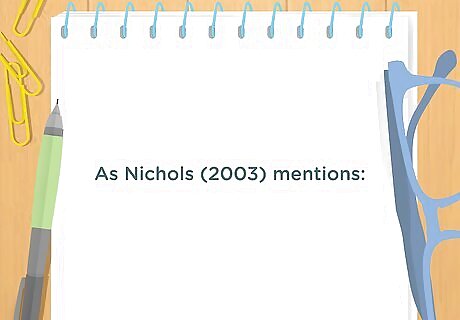
Put the signal phrase before the quote. A signal phrase is the part of the sentence that introduces the quote. This helps your reader understand that you are about to explain something with a quote. There are 3 common ways to introduce the quote in the text. You can: Include both the author and the year in the text. The page number will be in parentheses. Include only the author's name in the text. The year and page number will be in parentheses. Do not write the author's name or year of publication in the text. The name, year, and page number will be included in parentheses at the end.
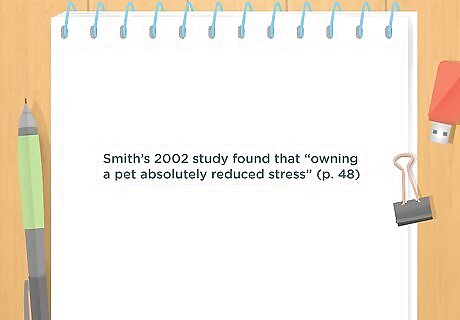
Write the author and the year in the signal phrase if you put the page number in parentheses. In this case, you do not include the year in parentheses, but you do write it elsewhere in the sentence. Put the page number in parentheses at the end. For example: Smith’s 2002 study found that “owning a pet absolutely reduced stress” (p. 48).

Name only the author in the signal phrase if you put the year and text in parentheses. This is one of the most common ways to write a signal phrase. In this case, put the year in parentheses next to the author’s name and the page number in parentheses at the end of the sentence. For example: Smith (2002) found that “owning a pet absolutely reduced stress” (p. 48).
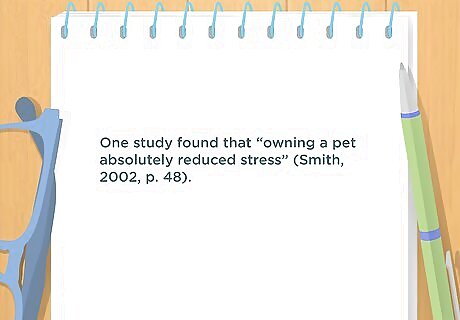
Include no citation information in the signal phrase if you put the author, year, and page number in parentheses. You must then cite the last name of the author, year of publication, and the page number all at the end in parentheses. You might start the sentence with "research states that..." or "one study found that..." For example: One study found that “owning a pet absolutely reduced stress” (Smith, 2002, p. 48).
Forming a Parenthetical Citation
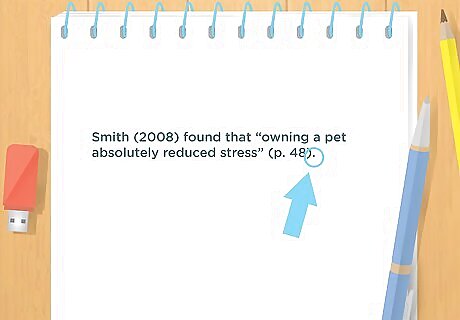
Put the parentheses after the quotations marks but before the period. Use round brackets, which look like this: ( ). Do not use square brackets, which look like this: [ ]. Your citation information will go between these parentheses. This is correct because the period comes after the parentheses: Smith (2008) found that “owning a pet absolutely reduced stress” (p. 48). This is incorrect because the period is placed before the citation: Smith (2008) found that “owning a pet absolutely reduced stress.” (p. 48)
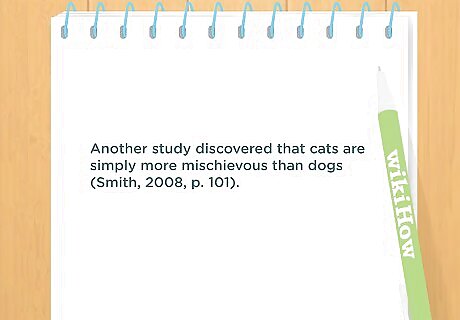
Give the author’s last name in the parentheses if it isn't in the signal phrase. The name always goes first in the parentheses. If you began your sentence or signal phrase with the author’s name, you do not have to include it in the parentheses. If there is only one author, write their last name followed by a comma. For example: (Smith, 2008, p. 101). If there are 2 authors, write both last names separated by a “&.” Follow the second name with a comma. For example: (Smith & Jones, 2008, p. 101). If there are 3-5 authors, cite all names the first time you use the citation. Then use the first author’s last name and “et. al” in following citations. The first citation might look like (Smith, Jones, & Wu, 2008, p. 101). The following citations might look like (Smith et. al 2008, p. 103). If there are more than 6 authors, use the first author’s last name and follow it with “et. al”. For example: (Smith et. al 2008, p. 101).
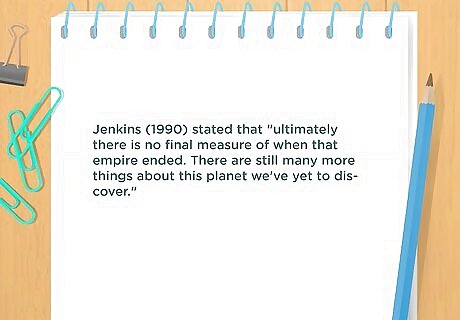
Follow the author’s name with the year of publication. The year of publication can be found in the publisher’s information at the beginning of a book or on the cover of a journal. If you cannot find the year, write “n.d.” instead. This stands for “no date.” If you mentioned the author’s name in a signal phrase, follow it immediately with the year in parentheses. You might write: “Jenkins (1990) stated that…” If you did not mention the author’s name in a signal phrase, include the year after the author’s name in the parentheses. There should be a comma after the year. This might look like: (Jenkins, 1990, p. 1).
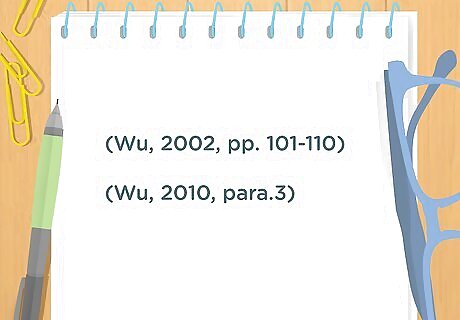
Include the page or paragraph number at the end of every quote. The page number always comes last in the parentheses. If you are citing a website or do not have page numbers, count how many paragraphs deep it is into the article. You must always include the page or paragraph number in the parentheses at the end. You cannot state it in the signal phrase at the beginning. The page number always comes last. Write “p.” before the page number.” If there is more than one page, use “pp.” For example: (Wu, 2002, pp. 101-110). If you are using the paragraph number, write “para.” before the number. For example: (Wu, 2010, para. 3).
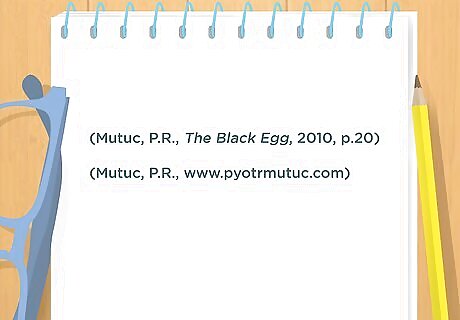
Include all references at the end in a bibliography. Any quote you cite in the body of your paragraph requires a full reference of the original source at the end of the paper. While the format for citing these depends on the type of source it is (book, article, website, etc), you will need the following information: Author’s last name and first initials Title of article Title of journal or book Year of publication Page range of cited article or chapter URL (if it is a website) or DOI number (if it is a peer-reviewed journal article)
Formatting a Long Quote

Put the quote on a new line if it is over 40 words long. Introduce the quote normally in your paragraph with a signal phrase. End the signal phrase with a colon and start the block quote on a new line. Your signal phrase may look like: When discussing the effect of pet ownership on humans, Smith asserts: The American Red Cross uses their annual report to call for more donations. In 2016, they said:
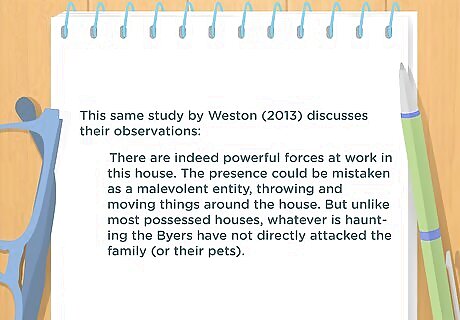
Indent the quote ⁄2 inch (13 mm) to the right instead of using quotation marks. The entire quote should be indented this way. It will look like a block of text within the paragraph. The indentation will signal that this is a long quote. Do not use quotations marks with a block quote. Keep the spacing the same as the rest of the essay. If the rest of the essay is double-spaced, your quote should be double-spaced. APA papers typically have margins of 1 inch (2.5 cm). This means that your block quote will be indented a total of 1.5 inches (3.8 cm) from the edge of the page.
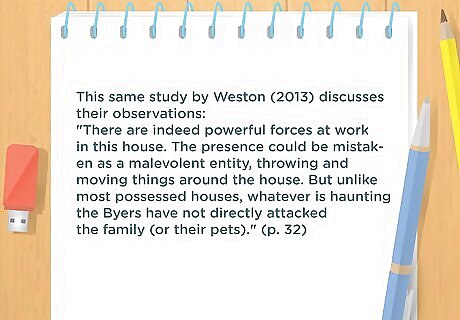
Insert your citation at the end after the last punctuation mark. If there is more than one sentence in the block quote, put it after the very last sentence. Include the author’s last name, year of publication, and the page or paragraph number. If the signal phrase includes the author’s name and year of publication, you only need to cite the page number at the end of the quote. If the signal phrase does not include this information, you must cite it at all in the parenthetical citation.
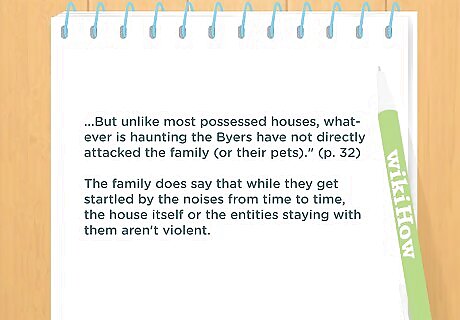
Return to normal formatting after the quote. If you are continuing the same paragraph as before the quote, go back to normal 1 inch (2.5 cm) margins. If you are starting a new paragraph after the block quote, indent the first line.
Learning Special Rules

Write the name of the organization if there is no author. Sometimes, large institutions, charities, think tanks, or governments produce studies or articles. In this case, there may not be an author. Cite the name of the organization where you would normally cite the author. You might write: The American Red Cross (2016) estimates that it responds to 66,000 disasters per year, “including single-family or apartment home fires, severe weather, floods and wildfires” (p. 2). In 2016, the American Red Cross estimated that it responds to 66,000 disasters per year, “including single-family or apartment home fires, severe weather, floods and wildfires” (p. 2). One organization estimated that it responds to 66,000 disasters per year, “including single-family or apartment home fires, severe weather, floods and wildfires” (American Red Cross, 2016, p. 2).

Include the title of the text if there is no author or organization. This may often be in the case when citing websites. Instead, put a shortened version of the title in quotation marks. Place the name of this work where you would normally write the author in the parentheses. For example: Huntington’s disease is a “neurological disorder that causes uncontrolled or jerking movements, difficulties with cognition, and emotional issues” (“Huntington’s Disease,” 2011, para. 1).
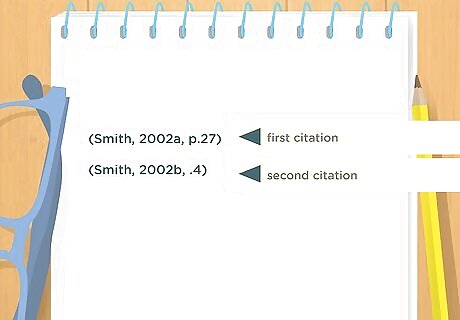
Add a letter to the year if the author published more than once that year. The first article you cited will be article “a” and the second will be article “b.” For example: if Smith has published 2 articles in 2002, your citations might look like (Smith, 2002a, p. 27) and (Smith, 2002b, p. 4).
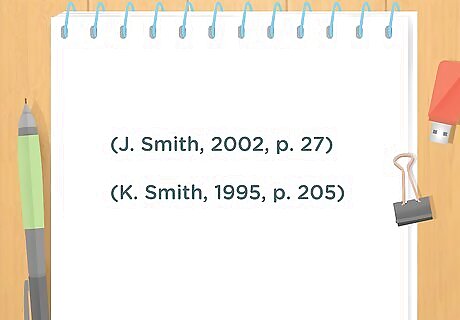
Include the author’s first initials if 2 authors share the same last name. If they share the same first initial as well, include their middle initial if they have one. The initial will go before their last name. This will help your readers distinguish between the 2 authors. If you are citing both John Smith and Kim Smith, your citations might look like this: (J. Smith, 2002, p. 27) (K. Smith, 1995, p. 205) In the signal phrase, you might write: K. Smith (1995) states that “the global economy will only continue to grow” (p. 205).
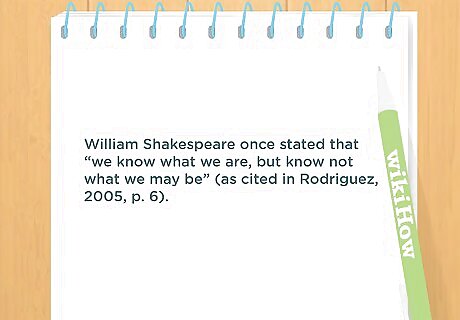
Cite the source you used, even if it is not the original source of the quote. State the original author in the signal phrase and cite the source you found it in the parentheses. You should use the phrase “as cited in” before the author’s name in the parentheses. You might write: William Shakespeare once stated that “we know what we are, but know not what we may be” (as cited in Rodriguez, 2005, p. 6).


















Comments
0 comment